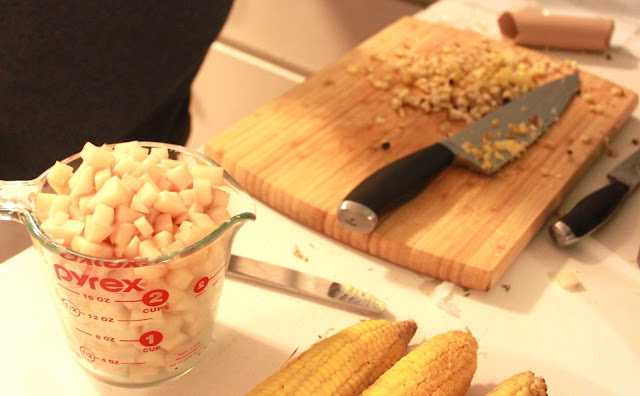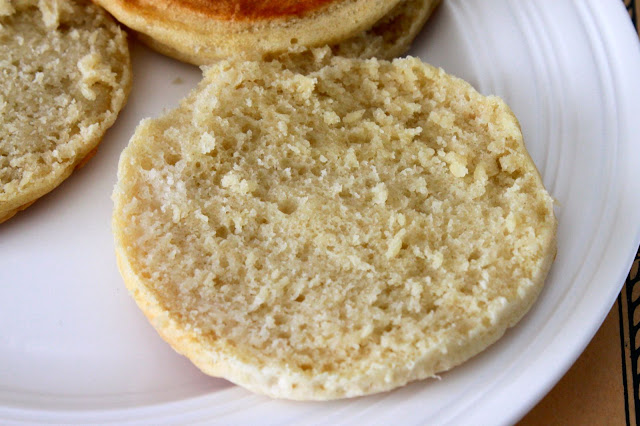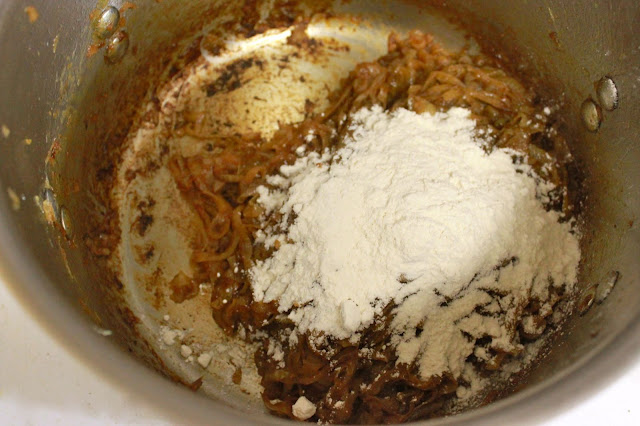This is how I do breakfast. Runny fried egg--check. Thick cut slice of bacon--check. Homemade totally awesome English muffin--double check.
I love English muffins. They're a great vehicle for sweet or savory breakfasts. Unfortunately, the ones you get from the supermarket usually have one of three problems:
1. They're refrigerated and have weird moisture issues.
2. They're expensive. Seriously almost a $1 a piece for something that is almost completely made of flour and powdered milk? It's really bad if your whole family has a daily habit like mine.
3. They just plain suck.
This recipe is adapted slightly from Alton Brown's super popular recipe. My version makes a double batch (20 muffins or so) and has a better flavor due to a longer rise. They freeze and defrost really well so you can whip one out any time you have a craving for an egg sandwich. If you're intimated by yeast breads, this would be a great recipe to cut your teeth with. There's no kneading, punching down, or shaping of the dough. The dough is fairly liquidy and gets spooned into a form and cooked on a hot griddle. If you can handle pancakes, you won't find these much more difficult.
If you bake at all, you probably have most of what you need already. You'll also need powdered milk, a packet of yeast, and some kind of open circular form at least 3/4 inch deep. Alton recommends taking both ends off some tuna cans. Pancake rings would also work. And I use the rings from my canning jars. They're not the best choice because they're not very deep and tend to overflow, but they get the job done.
In separate bowls, you rehydrate the milk and the yeast.
If you've never worked with yeast before just know that a controlled temperature is your friend. This goes for both the water you use to rehydrate the yeast and the environment you let the dough rise in.
Stir the yeast into cool or luke warm water. Don't use hot water since a temperature of 140 degrees will instantly kill yeast. Let the yeast dissolve completely into the water. You shouldn't see any granules and it should look like a cloudy slurry. If you look closely there should be tiny bubbles on the surface of the yeast mixture, then you know it's alive.
The dough gets stirred together and put in a warm spot to rise. I like to preheat my oven to the lowest temperature and then shut it off while I'm mixing up the dough. That way I have an environment a bit warmer than room temperature for the yeast to multiply in. The dough should double in size during the rise. This will go faster or slower depending on the temperature. Here's a before and after:
Then I beat in a little baking soda, which creates even more bubbling action, helping make the characteristic nooks and crannies. Then I let the dough rest for several minutes while I prep the griddle. I'm still playing around with the best way to maximize the nooks and crannies. You'll definitely have some, but I'll update this post once I've figured out the best way to get the full on sponge texture you get with commercial English muffins.

You could also make these in a skillet or frying pan. You'll want medium heat and a very light coating of oil. Make sure you spray your molds with a little oil too. You can play with the cooking time. At 300 degrees mine take 5 minutes on the first side and 4 on the second. If you find them browning too rapidly, turn down the heat. If you end up with gummy centers you can put them on a cookie sheet and finish them in the oven for a few minutes. A really nice touch is to dust the the griddle with cornmeal or semolina flour before you scoop out the muffins (in my rush to breakfast glory, I always forget to do this). I use a generous 1/4 cup to portion the dough.
Update 5/10/12: As is often the case with me, I have a new method born out of laziness. I mix up the dough the night before, cover the bowl in plastic wrap, and stick it in the refrigerator. The next day I preheat my oven to the lowest setting and shut it off. I take out the dough, beat in the remaining 2 teaspoons of salt, and let it rise in the warm oven for 30 minutes. No baking soda is necessary with this method, you'll have a great yeast flavor and tons of nooks and crannies. Then proceed with the recipe as usual. If you don't have time for an overnight refrigerator rise, you'll still get better nooks and crannies if you let the dough rise again after you beat in the salt. With an additional rise I also found I had a slightly higher yield (23 muffins versus 20). I'm guessing due to the increase of gas and therefore the increase in volume of the dough. I also calculated the carbs for my dad who is a diabetic and there are approximately 20 in a muffin (assuming a yield of 23), this could vary quite a bit depending on the weight of your flour though.
English Muffins
Adapted from
Alton Brown via
She Simmers
Yields approx. 20 muffins
Cooking time: 2 hours 15 minutes (45 active)
Ingredients
Mixture #1:
72 grams (1 cup) nonfat milk powder
16 fl. oz. (2 cups) hot water
28 grams (2 tablespoons) sugar
4 grams (2 teaspoons) salt
28 grams (2 tablespoons) melted shortening or vegetable oil (Use something flavorless.)
Mixture #2:
7 grams (1 envelope) dry yeast
A pinch of sugar
5.4 fl. oz. (2/3 cup) lukewarm water
500 grams (4 cups) all-purpose flour
4 grams (2 teaspoons) salt
2 teaspoons baking soda
vegetable oil
Directions
1. Preheat your oven to the lowest temperature and when it's ready shut it off and leave the door closed.
2. In a large bowl stir together the powdered milk and hot water. Then add the rest of the ingredients in Mixture #1.
3. In a small bowl stir together Mixture #2 and let it sit a few minutes until the yeast is dissolved.
4. Make sure the milk mixture has cooled to lukewarm and add the yeast mixture to the larger bowl and combine. Then beat in all the flour.
5. Put the bowl in the oven and let rise 75 to 90 minutes or until doubled in volume.***Or put the bowl in the fridge for an overnight rise. See update above.***
6. Remove from oven, beat in the remainder of the salt and the baking soda. Let dough rest while you prep the griddle.
7. Preheat an electric griddle to 300 degrees or a frying pan over medium heat. Add molds and lightly spray everything with oil.
8. Scoop a generous 1/4 cup of dough into each mold and cook until golden brown, about 5 minutes. Flip with tongs and cook a few more minutes.
9. Pop the muffins out of the molds. Split with a fork and serve. Leftover muffins can be cooled and frozen in freezer bags. To reheat, just thaw in the microwave for a few seconds, split, and toast if you want.
 Well the house is officially broken in. Over the holiday weekend I set off the fire alarm for the first time making burgers. Jeremy said I made the case for my high powered vent hood when we remodel the kitchen. While the house was airing out via a box fan, we retreated to the sun porch. The sun porch is the only room that's close to done. Don't get me wrong, there's still twenty things that would make great improvements, but it's clean, functional, and looks pretty good.
Well the house is officially broken in. Over the holiday weekend I set off the fire alarm for the first time making burgers. Jeremy said I made the case for my high powered vent hood when we remodel the kitchen. While the house was airing out via a box fan, we retreated to the sun porch. The sun porch is the only room that's close to done. Don't get me wrong, there's still twenty things that would make great improvements, but it's clean, functional, and looks pretty good. The other big change was the electrical items. The damp-rated fan is new and provides a lot more light and we added an outdoor electrical outlet. I love the outdoor outlet because now we can plug in an Ipod dock outside and listen to music on the porch and in the front yard. If this becomes even more of a dining space down the road, we can also plug in a blender, electric kettle, etc. And it's great for a vacuum cleaner too.
The other big change was the electrical items. The damp-rated fan is new and provides a lot more light and we added an outdoor electrical outlet. I love the outdoor outlet because now we can plug in an Ipod dock outside and listen to music on the porch and in the front yard. If this becomes even more of a dining space down the road, we can also plug in a blender, electric kettle, etc. And it's great for a vacuum cleaner too. I also want to build a legitimate corner shelf for my Meyer lemon tree and replace the screen, which has holes and paint smears. I'm also contemplating a built-in bench or a bistro set more scaled to the small space. The porch is a little over 7' by 10'. I think a bench and low tables that do double duty as footstools would be neat. Something like the first photo on this blog but with a more seaside cottage look. For now, it's still a great space to enjoy the long summers and mild falls we have here in Atlanta.
I also want to build a legitimate corner shelf for my Meyer lemon tree and replace the screen, which has holes and paint smears. I'm also contemplating a built-in bench or a bistro set more scaled to the small space. The porch is a little over 7' by 10'. I think a bench and low tables that do double duty as footstools would be neat. Something like the first photo on this blog but with a more seaside cottage look. For now, it's still a great space to enjoy the long summers and mild falls we have here in Atlanta. 


















































